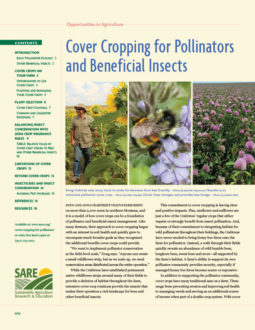- Conservation Technology Information Center (CTIC). 2014. Report of the 2013-14 Cover Crops Survey. CTIC and North Central SARE. sare.org/2013-cover-crop-survey.
- Altieri, M., and H. Wilson. 2010. Restoring Plant Diversity and Soil Health in Napa and Sonoma Vineyards: Scaling Up an Agroecologically Based Pest Management Strategy. Project funded by USDA-SARE. To access, visit sare.org/project-reports and search by project number FW08-311.
- Clark, A. (ed.). 2007. Managing Cover Crops Profitably, 3rd ed. SARE: College Park, MD. sare.org/mccp.
- Altieri, M., C. Nicholls, and M. Fritz. 2005. Manage Insects on Your Farm: A Guide to Ecological Strategies. SARE: College Park, MD. sare.org/manage-insects.
- Tallman, S. 2012. No-Till Case Study, Miller Farm: Restoring Grazing Land with Cover Crops. The National Center for Appropriate Technology – National Sustainable Agriculture Information Service (NCAT-ATTRA): Butte, MT.
- Cartwright, L., and B. Kirwan. 2014. Cover Crop Economics Decision Support Tool. USDA Natural Resources Conservation Service (NRCS).
- Singer, J. W., S. M. Nusser, and C. J. Alf. 2007. Are Cover Crops Being Used in the U.S. Corn Belt?. Journal of Soil and Water Conservation 62(5): 353-358.
- Minnesota Department of Agriculture. Cover Crops. In Conservation Practices: Minnesota Conservation Funding Guide.
- Morris, R. August 23, 2013. Flax Being Grown for Fiber in North Carolina. A North Carolina Department of Agriculture and Consumer Services press release.
- Hayden, J. 2014. Investigating Ways to Improve Native Pollinator Floral Resources by Comparing Multipurpose Cover Crops of Phacelia, Buckwheat, and a Commercial Bee Forage Mix. Project funded by USDA-SARE. To access, visit sare.org/project-reports and search by project number FNE13-781.
- Johnson, J. Termination Time for Cover Crops. USDA Natural Resources Conservation Service (NRCS) Iowa.
- USDA Natural Resources Conservation Service (NRCS). Cover Crop Termination Guidelines, Version
- USDA Agricultural Research Service (ARS). 2015. Cover Crop Chart. USDA-ARS Northern Great Plains Research Laboratory: Mandan, ND. https://www.ars.usda.gov/plains-area/mandan-nd/ngprl/docs/cover-crop-chart/.
- McCraw, D., and M. Smith. Use of Legumes in Pecan Orchards. Oklahoma Cooperative Extension Service fact sheet HLA-6250. https://pods.dasnr.okstate.edu/docushare/dsweb/Get/Document-2570/HLA-6250.pdf.
- Irvin, N., and M. Hoddle. 2010. Using Nectar Cover Cropping in Vineyards for Sustainable Pest Management. Project funded by USDA-SARE. To access, visit sare.org/project-reports and search by project number SW07-022.
- Johnson, R., and K. Sieving. 2013. Do Human Modified Landscapes Affect Solitary Bee Diversity, Foraging, and Reproduction in Northern Florida?. Project funded by USDA-SARE. To access, visit sare.org/project-reports and search by project number GS10-092.
- Salon, P. R. 2012. Diverse Cover Crop Mixes for Good Soil Health. USDA-NRCS Big Flats Plant Materials Center: Corning, NY.
- Groff, S. 2008. Mixtures and Cocktails: Soil is Meant to be Covered. Journal of Soil and Water Conservation 63(4): 110A-111A.
- Hoorman, J. J., R. Islam, and A. Sundermeier. 2009. Sustainable Crop Rotations with Cover Crops. Ohio State University Sustainable Agriculture Fact Sheets.
- Pullins, E. E., R. L. Myers, and H. C. Minor. 1997. Alternative Crops in DoubleCrop Systems for Missouri. University of Missouri Extension Publications. https://extension.missouri.edu/p/G4090.
- Gross, P., C. Curell, and D. Mutch. 2012. Cover Crop Choices Following Winter Wheat. Michigan State University Extension. https://msue.anr.msu.edu/news/cover_crop_choices_following_winter_wheat.
- Union of Concerned Scientists. 2013. Cover Crops: Public Investments Could Produce Big Payoffs. https://www.ucsusa.org/food_and_agriculture/solutions/advance-sustainable-agriculture/cover-crops.html.
- Hoorman, J. J. 2009. Using Cover Crops to Improve Soil and Water Quality. Ohio State University Sustainable Agriculture Fact Sheets. https://ohioline.osu.edu/factsheet/anr-57.
- Kaspar, T. C., E. J. Kladivko, J. W. Singer, S. Morse, and D. R. Mutch. 2008. Potential and Limitations of Cover Crops, Living Mulches, and Perennials to Reduce Nutrient Losses to Water Sources from Agricultural Fields in the Upper Mississippi River Basin. In Final Report: Gulf Hypoxia and Local Water Quality Concerns Workshop: 127-148. American Society of Agricultural and Biological Engineers: St. Joseph, MI.
- Blaauw, B., and R. Isaacs. 2011. Native Plant Conservation Strips for Sustainable Pollination and Pest Control in Fruit Crops. Project funded by USDA-SARE. To access, visit sare.org/project-reports and search by project number LNC08-297.
- Walton, N. 2009. Evaluation of Supplemental Flowering Plant Strips for Sustainable Enhancement of Beneficial Insects. Project funded by USDA-SARE. To access, visit sare.org/project-reports and search by project number GNC07-086.
- Hopwood, J., M. Vaughan, M. Shepherd, D. Biddinger, E. Mader, S. H. Black, and C. Mazzacano. 2012. Are Neonicotinoids Killing Bees?. Xerces Society for Invertebrate Conservation: Portland, OR. www.xerces.org/neonicotinoids-and-bees.
- Scholer, J., and V. Krischik. 2014. Chronic Exposure of Imidacloprid and Clothianidin Reduce Queen Survival, Foraging, and Nectar Storing in Colonies of Bombus impatiens. PLOS ONE 9(3), e91573.
- Easton, A. H., and D. Goulson. 2013. The Neonicotinoid Insecticide Imidacloprid Repels Pollinating Flies and Beetles at Field-Realistic Concentrations. PLOS ONE 8(1), e54819.
- Whitehorn, P. R., S. O’Connor, F. L. Wackers, and D. Goulson. 2012. Neonicotinoid Pesticide Reduces Bumble Bee Colony Growth and Queen Production. Science 336(6079): 351-352.
- Blacquiere, T., G. Smagghe, C. A. Van Gestel, and V. Mommaerts. 2012. Neonicotinoids in Bees: A Review on Concentrations, Side-Effects and Risk Assessment. Ecotoxicology 21(4): 973-992.
- Schomberg, H. 2004. Enhancing Sustainability in Cotton Production Through Reduced Chemical Inputs, Cover Crops, and Conservation Tillage. Project funded by USDA-SARE. To access, visit sare.org/project-reports and search by project number LS01-121.
Cover Cropping for Pollinators and Beneficial Insects
References
SARE Outreach
2015 | 16 pages
